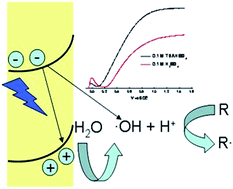Some aspects of the charge transfer dynamics in nanostructured WO3 films†
Abstract
The photoanodic response of two different types of nanocrystalline WO3 electrodes prepared by following either the sol gel approach or the accelerated anodization route was explored in sulfate containing electrolytes with the aim of exploring the mechanism of charge separation at WO3/electrolyte interfaces. Combined evidence by electrochemical impedance spectroscopy and transient absorption spectroscopy indicates that hole transfer occurs through the valence band and that, under applied bias, the voltage drop involves predominantly the space charge layer of the semiconductor, controlling the photocurrent via potential-induced variations of hole density at the surface of WO3. OH radicals were found among the primary water oxidation intermediates, and are partly responsible for mediated back recombination. The generation of hydroxyl radicals suggests, however, that WO3 based materials can find promising applications in environmental photoremediation under visible light, promoting ˙OH mediated oxidation of impervious contaminants. In principle, the removal of ˙OH by organic scavengers will also optimize the photocurrent generation in photoelectrochemical cells where the generation of hydrogen can be coupled to environmental decontamination.

- This article is part of the themed collection: Water splitting and photocatalysis

 Please wait while we load your content...
Please wait while we load your content...